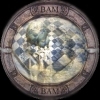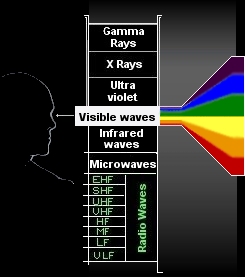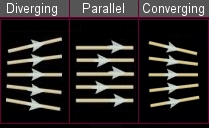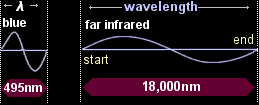
Visible light
The electromagnetic spectrum covers a broad range of phenomenon with radio waves at one end and gamma rays at the other, visible light is somewhere towards the middle of this spectrum tucked in between infrared waves and ultra violet.
Light itself is not visible we only see reflected objects not what actually illuminates them. The beams of light you see from a cinema projector are caused by the light shining through the atmosphere in the room and illuminating dust particles or smoke if smoking is permitted. At rock concerts smoke machines use this effect so you can see the beams of light coming from a laser.
We view our world through a narrow, visible slit in the electromagnetic spectrum.
Visible Light in the em spectrum

Electromagnetic wavelengths [nm = Nanometres ]
Em spectrum - Plate 3
Electromagnetic Transverse wave Plate 4
Reflected Light
You can see an
object only if light from it enters your eye's.
Objects such as the sun are called "Luminous Sources". Most objects
reflect light from a luminous source.
These sources radiate light when their atoms are excited as a result of receiving energy.
In a light bulb the energy comes from electricity, these excited atoms give off their
light in a haphazard way and is said
to be incoherent light.
Light rays
The direction of the path in which the light is travelling is called a "Ray" and is represented in the diagram [to the right] by a straight line with an arrow on it.A beam is a stream of light and is shown by a number of rays, it may be Diverging, Parallel or Converging.

Laws of reflection.


The angle of incidence is equal to the angle of reflection


Nanometres
The wavelength of light is measured in Nanometres. One nanometre is equal to one-billionth of a metre. The width of a strand of hair is about 100,000 Nanometres wide.

Nanometres in SI units
The wavelength of a light wave is the distance
between the beginning and the end of a cycle.
The higher the Frequency, the longer the
Wavelength